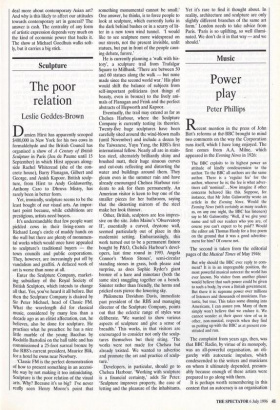Changing landscape
Edward Lucie-Smith believes contemporary Asian art is about to make a major impact over here The world of contemporary art is vol- cano country — full of seismic rumblings and warning plumes of steam or smoke. Those of us who inhabit it have a habit of ignoring these signs, despite the fact that innovation is supposed to be our business. Then the eruption comes — the birth of Pop Art or the triumph of lumps of dead meat swimming in tanks of formaldehyde — and the whole landscape suddenly
changes around us. Having survived a num- ber of these transformations in the past, a pricking in my thumbs tells me that anoth- er one is about to take place.
One sign of it is a small but fairly choice exhibition in a conservative gallery not noted for its links to innovative art. Michael Goedhuis in Mount Street is best known as a dealer in Chinese and Japanese antiquities, but has recently branched into Chinese 20th-century painting. His current show (until 31 July) features contemporary artists working in variants of the traditional ink-and-brush tradition. As the catalogue which accompanies the exhibition notes, the new Chinese painting pays homage to western Modernist experimentation, partic- ularly Abstract Expressionism, but sees this as a way of freeing itself from traditional bonds. Age-old techniques, such as the fluid 'boneless' style which can be traced back as far as the Tang Dynasty, are applied to new ends. The results have a delight in sheer manual dexterity which has vanished almost entirely from British art.
Modernist paintings of this kind, making use of traditional techniques and materials, have created a strong market for them- selves in Hong Kong and Taiwan. Works by leading masters command prices well into six figures, as recent auction records show. But this is not the only kind of contempo- rary Chinese art on the market. In 1994, for instance, Marlborough Fine Art staged a show of New Art from China, which con- sisted entirely of works in the purely west- ern technique of oil on canvas. Some were vaguely expressionist, others were in a style which has come to be labelled Political Pep, featuring images of Mao, plus ironic Autumn Sunshine; 1996 by Yang Yanping, on show at the Michael Goedhuis Gallery
borrowings from the collective art made by peasant communes, which was in high offi- cial favour during the years of China's Cul- tural Revolution. In the same year, the enterprising Museum of Modern Art in Oxford put on a China Avant-Garde exhibi- tion which included not only the Political Pop artists, but makers of environments in the western avant-garde manner. The most imaginative of the latter, Wenda Gu, is cur- rently back in England, in Nottingham, making, as he tells me in a recent letter, 'a giant British national flag made of pure British hair'.
The kind of phenomena I am describing are not limited to China alone, There is a vigorous production of contemporary art in Japan, and this, too, is divided in the same fashion — some uses purely western tech- niques, some adapts traditional methods to new circumstances. Until recently, howev- er, the attention paid to all this activity by western critics was fairly minimal. The Japanese Gutai Group caused a brief stir in Europe during the 1960s — helped by the wealth of its founder, the industrialist and painter Jiro Yoshihara (only in Japan would such a combination be regarded as commonplace) and by the enthusiastic sup- port of the French critic Michel Tapie, inventor of the phrase art autre. In general, however, the new art of the Far East was looked upon rather condescendingly. The consensus was that what was being done there was more or less wholly derivative from things being made in the West, the language barrier was impenetrable, and anyway who could remember the names?
There are now indications that all this is about to change. I haveiisted a number of events observable in Britain, but in fact the most important can be seen in the United States, which continues to set the agenda for contemporary art everywhere. One was the exhibition Scream Against the Sky, seen at the downtown branch of the Guggen- heim Museum in New York in 1994. This was the first really thorough survey under- taken in the West of post-war art in Japan, though it confined itself to things which were indisputably avant-garde in western terms, and paid no attention to radical developments in ink-painting or printmak- ing — both vital parts of a continuing Japanese tradition. Perhaps even more sig- nificant is the upcoming appearance, from Abrams, the most prestigious publisher of art books in the United States, of a large illustrated survey, Contemporary Art in Asia. This covers territories still less known to western critics than China and Japan Indonesia, Thailand and the Philippines, as well as India and South Korea. The book accompanies an exhibition which opens in October this year at the Asia Society Gal- leries in New York. 'Key topics,' says the blurb, 'include politics, religion and women's issues.' If he or she had been hon- est, the blurb writer would have added the word 'money' to the list.
Why are we now going to hear a great deal more about contemporary Asian art? And why is this likely to affect our attitudes towards contemporary art in general? The answer is cash. The centrality of any form of artistic expression depends very much on the kind of economic power that backs it. The show at Michael Goedhuis walks soft- ly, but it carries a big stick.



























































 Previous page
Previous page